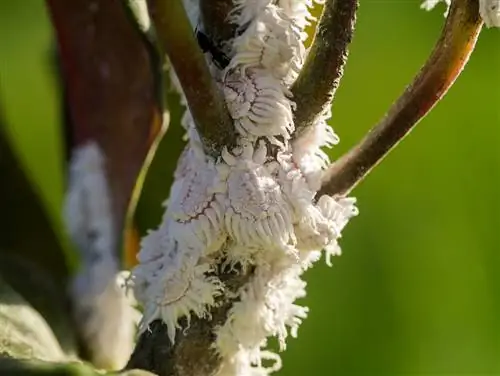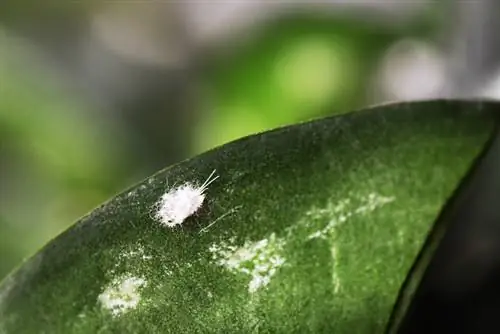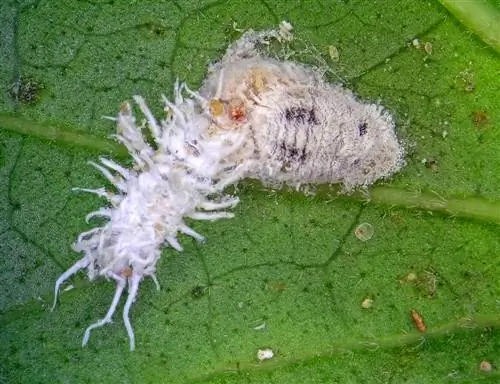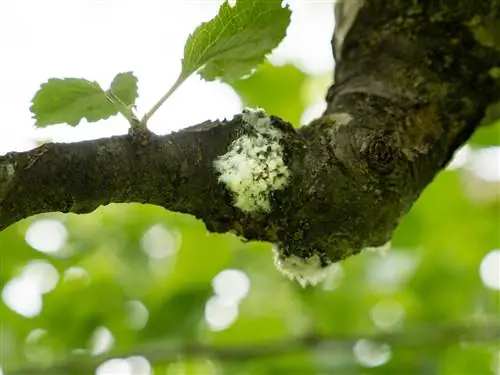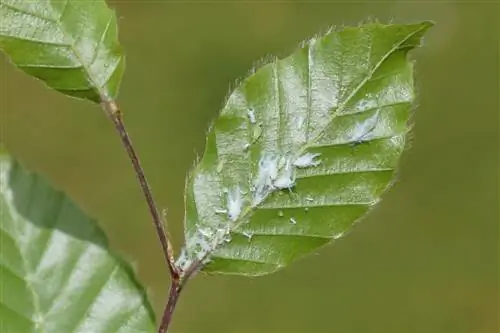- Author admin [email protected].
- Public 2023-12-26 14:17.
- Last modified 2025-06-01 06:02.
If the leaves of a plant feel strangely sticky and there are perhaps some “piles” resembling small cotton balls on them, then it is most likely mealybugs. This is how you get rid of the pests.
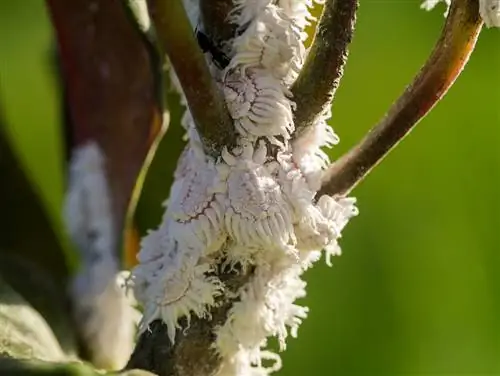
- Mealybugs often hide themselves and their eggs in the plant substrate, in the leaf sheaths or axils. They are often difficult to detect in the early stages of an infestation.
- The pests protect themselves and their offspring with a layer of wax, which is why many biological control measures do not work or hardly work.
- (Homemade) plant protection products based on paraffin oil or spirit are very suitable for effective control, but these are not tolerated by all plant species. Orchids in particular are very sensitive.
- Some beneficial insects such as lacewing larvae or parasitic wasps as well as a bright location and high humidity (especially during the heating period in winter!) help against mealybugs and mealybugs.
Identifying mealybugs
Mealybugs, often referred to as mealybugs or root lice, are stubborn and difficult to control plant pests. They suck on all parts of a plant to get their nutritious sap. They not only excrete honeydew, but also toxins that add additional damage to the affected plants. The adults are surrounded by a waxy layer that protects them from enemies and harmful environmental influences. But it's not just this that makes effective control difficult, but also the rapid reproduction rate and resourceful survival strategies.
Not only do mealybugs like to hide their eggs where they are difficult to detect - for example in the leaf axils, in bracts or in the substrate - they are also able to retreat when living conditions worsen and better times come to wait and see. So don't be too quick to lull yourself into security after supposedly successful countermeasures: the animals often reappear after a few months of rest and spread en masse again.
Appearance
As long as a mealybug infestation is still in its early stages, it is not easy to detect. However, the animals have a very distinctive appearance, which is why you cannot confuse them. And this is what the pests look like:
- between one and twelve millimeters in size
- colored white, pink or light brown
- covered by a white layer of wax
- there are whitish threads on this
- reminiscent of little cotton balls
Basically, both the adults and their eggs and larvae can be found on all parts of the plant. Mealybugs are not only found on the leaves, but also on (soft) shoots and stems, on the leaf axils and even on the roots - of course they are particularly difficult to find here.
malicious image
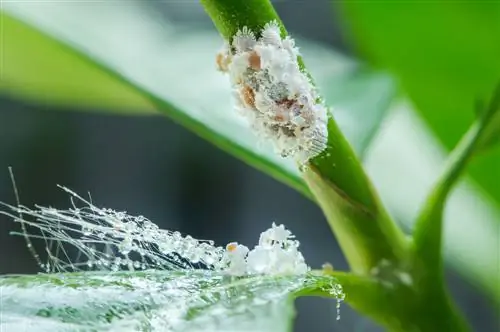
Mealybugs leave a sticky coating on the leaves
The damage to infected plants caused by mealybugs is much less specific. In principle, these can also come from other pests, although the same plant can of course be colonized by different types of plant pests. You can tell that something is absolutely wrong and you need to take urgent action by these symptoms:
- Leaves roll up
- Leaves turn yellow and fall off
- sticky coating on leaves and other parts of plants
- this can also drip onto the surface
- whitish webs on leaves and other parts of plants
- In case of root infection, whitish smear on the inside of plant pots
The sticky, often dripping coating is so-called honeydew, which is excreted by mealybugs (and other plant pests as well). Honeydew, in turn, forms the ideal basis for the settlement of sooty mold fungi, which often appear as a result of a pest infestation. The affected parts of the plant then look as if they are covered in black goo.
Excretions and fungi should always be wiped off as they hinder the plant's photosynthesis and thus its growth
Excursus
Why it is so important to combat mealybug infestation early
Since mealybugs reproduce extremely quickly and the animals are not very picky when choosing their host, the infestation is not limited to one plant. Instead, the infection quickly spreads to other plants, which are then also severely weakened. If effective countermeasures do not take effect in time, an infected plant will usually die quickly.
Which plants are particularly at risk?
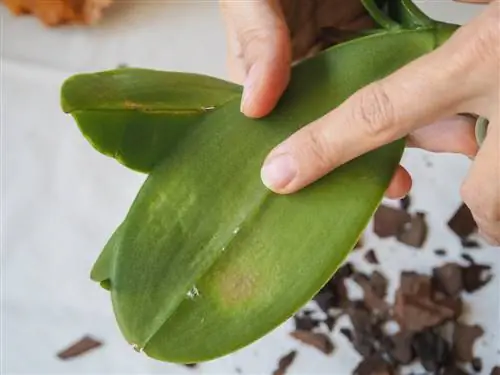
Orchids are often attacked by mealybugs
Basically all plants can be attacked by mealybugs. However, sclerophyllous plants are particularly popular with stubborn pests, especially when they are cultivated indoors - the living conditions here are optimal, especially during the winter months. But the animals can also be found outdoors, but more often in the hot and dry summer months.
However, the following plant species are particularly often affected:
| Houseplants | Garden Plants |
|---|---|
| Aloe Vera (Aloe vera) | Apple tree (Malus domestica) |
| Birch fig (Ficus benjamina) | Bamboo (various) |
| Elephant foot (Beaucarnea recurvata) | Boxwood (Buxus sempervirens) |
| Money tree (Crassula ovata) | Hydrangea (Hydrangea) |
| Rubber tree (Ficus elastica) | Oleander (Nerium oleander) |
| Cacti (various) | Olive tree (Olea europaea) |
| Orchids (various) | Lemon tree (Citrus × limon) |
| Yucca palm / palm lily (Yucca elephantipes) | |
| Poinsettia (Euphorbia pulcherrima) |
Excursus
Why is mealybug infestation so common on orchids?
Orchids are particularly often affected by mealybug infestation. This is primarily because these popular exotics are quite demanding to care for, depending on the species and variety. To protect the flowering plants from infestation, care for and fertilize them professionally and, above all, ensure that they are in an optimally bright location with appropriate temperatures and high humidity. By the way: Most of the time you bring the mealy bug infestation into the house with plants that are already infected.
What helps? Effectively combat mealybugs
“Know your enemy and you will defeat him!”
Because mealybugs are so stubborn, applying a spray once is not enough. Instead, in order to achieve ultimate (and not just temporary) success, you should combine several methods and be one thing: perseverance! It is particularly important to regularly collect discovered animals; a slightly moistened cotton swab will serve you well, especially in hard-to-reach places such as leaf axils. It also makes sense to wipe leaves and other parts of plants with a damp cloth - baby wipes are ideal for this purpose.
You should also definitely take these measures:
- Isolate the affected plant.
- Place it in the coolest and brightest possible place.
- Of course, both are only possible with potted plants.
- Clean the affected plant parts and collect the mealybugs.
- If the infestation is too severe, cut the plant back (severely).
- Repot the plant in fresh, sterilized substrate.
Suitable home remedies

Spirit and soap are a very effective home remedy against mealybugs
A classic home remedy for mealybugs is denatured alcohol. Of course, you don't use this pure - unless you want to treat an infected cactus - but mix a solution of water, soft soap and spirit. For this you need:
- a liter of water
- 15 milliliters of denatured alcohol
- 15 milliliters of soft soap or paraffin oil

Mix all the ingredients and spray the affected plants about every two days. However, sensitive plants such as orchids should not be sprayed; instead, brush the mixture directly onto the affected parts of the plant. Denatured alcohol is so good for combating mealybugs because it softens the protective waxy shell and makes the animals vulnerable in the first place. The agent also penetrates the body and causes the pests to die.
But many home-made plant extracts also work effectively against mealybugs and at the same time offer the advantage of fertilizing the plants treated with them and strengthening their defense system. These preparations are particularly suitable against mealybugs and mealybugs:
| Suitable plant | Preparation | Application |
|---|---|---|
| bracken | Simmer 100 grams of fresh leaves in a liter of water for one hour | Let the tea cool, strain and spray plants with the undiluted decoction |
| Oregano | Pour 100 grams of fresh oregano herb or 10 grams of dried one liter of boiling water over it and let it steep for at least 15 minutes | Let cool, strain (if necessary) and dilute 1:3 with water, spray plants |
| Stinging nettles | Pour 200 grams of fresh nettle leaves (from non-flowering plants!) with one liter of water and leave to infuse for eight hours | strain and spray plants undiluted |
| garlic | Chop 50 grams of fresh garlic clove, pour one liter of boiling water over it, let it steep for at least half an hour | strain, spray plants undiluted |
When preparing, make sure to cut or chop the parts of the plant used as small as possible - the better the ingredients that are supposed to drive away the mealybugs will dissolve. Spray the affected plants several times at intervals of no more than two days for this measure to be successful. However, such herbal sprays are only successful if the infestation is incipient or moderate. However, if the mealybugs have already spread significantly, harsher methods make sense.
How to remove mealybugs from roots
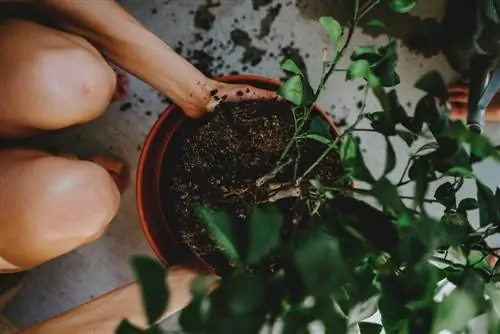
If the mealybugs have attacked the roots, the plant must be repotted
If the mealybugs are hiding in the roots, you must proceed as follows:
- Pott out the affected plant.
- Carefully free the roots from the substrate.
- Rinse off with a strong jet of water (e.g. in the shower).
- Clean and disinfect the planter.
- High-proof alcohol, for example, is suitable for this.
- Alternatively, you can use a new pot and throw away the old one.
- Disinfect the fresh substrate in the oven or microwave (instructions: see below).
- Pott the plant in the fresh and disinfected substrate.
- Pour it carefully, for example with nettle tea.
The procedure described is not only useful for root lice, but also for general mealybug infestation. As soon as the pests appear somewhere on a plant, just assume that animals and eggs are also in the substrate.
Fight Mealybugs Naturally - Biological Antidotes
Biological sprays and pesticides - for example neem oil or preparations based on the natural active ingredient pyrethrum are not suitable as a control measure for mealybugs. The reason for this is the hard wax layer that protects the animals from such influences - the remedies that are otherwise so successful against other pests fail miserably here. The only thing that is actually effective is the use of spirit and soft soap or paraffin oil, as already described, because these agents soften the wax and can kill the lice.
However, spirit as well as paraffin and soft soap have a significant disadvantage: not all plants tolerate treatment with it and even die afterwards. Therefore, always try out an application on a small leaf or something similar first and see how your plant reacts to it. Also make sure not to use the home remedy in direct sunlight - the result would be unsightly stains due to burns.
Beneficial insects against mealybugs
Pests like the annoying mealybugs can, however, also be combated in other, completely non-toxic ways: The little animals have many predators who are only too happy to eat eggs, larvae and even adult lice and thus curb the infestation in a completely natural way. However, there are some important tips to consider when using so-called beneficial insects to ensure that this method is successful:
- do not use insecticides and other toxic substances at the same time
- these also kill the beneficial insects
- at best, avoid using such products six weeks before use
- Use beneficial insects as early as possible
- If there is a severe infestation, even the beneficial insects can't keep up with eating
- then first apply a beneficial insect-friendly agent (e.g. based on rapeseed oil)
- only then use beneficial insects
- Carefully follow the manufacturer's instructions according to the quantity to be applied, ambient temperature and humidity
It is particularly important to think carefully and weigh up the number of beneficial insects required: if you use too few of these animals, they will not be able to combat the mealybug plague. However, if there are too many animals on a plant, they tend to eat each other instead of attacking the pest larvae.
The following beneficial insects in particular have mealybugs (and other common pests!) on their menu.
- Australian ladybird: particularly effective against mealybugs - only 25 of these animals eat all the mealybugs in an area of up to 13 square meters, only in closed rooms and at an ambient temperature of 20° C can be used; Adult beetles are delivered, which are released directly onto the infected plants, keeping windows and doors closed (danger of migration!), spraying plants regularly with water, as ladybirds need drinking water
- lacewing larvae: eat mealybugs between the second and third larval instars, then pupate and fly out of the apartment on their own as adults, are supplied by online retailers in the first larval instar, repeated use useful
- Parasitic wasps: Species Leptomastix dactylopii is specialized on mealybugs, application similar to the Australian ladybird, both species can also be used together
Parasitic wasps and ladybirds have in common that both are only active in a warm environment. If the temperature is permanently less than 15 °C, the use of lacewing larvae makes more sense. You can encourage them to lay eggs again by placing a shallow bowl of honey or sugar water on the windowsill. In this way, you ensure that more beneficial offspring are born, which in turn keeps the mealybugs at bay.
Beneficial insects in the garden
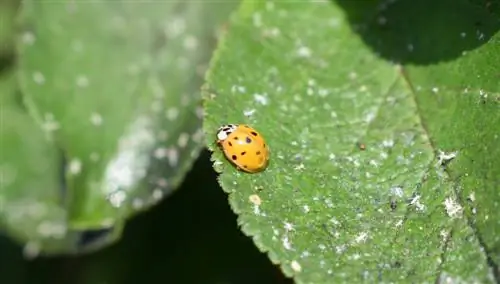
Ladybirds love to eat mealybugs
In addition, the targeted use of beneficial insects is naturally more effective in closed rooms - such as those in the apartment, winter garden or greenhouse - than in the garden, where the animals can wander off. However, such a garden can be designed to be friendly to beneficial insects so that you can attract lacewings, parasitic wasps, ladybirds, etc. and in this way maintain the ecological balance. Many useful insects in the garden also have the advantage that pests have no chance of spreading.
The little animals feel at home in gardens with many native flowering plants, where they find food in abundance. Flowering hedges, wild plants such as yarrow, chamomile and corn poppies and umbelliferous plants are particularly attractive. Furthermore, you provide the beneficial insects with sought-after nesting and overwintering places with a strategically placed insect hotel and one or two piles of brushwood or stones.
If nothing else works - take chemical action against mealybugs
Home remedies and beneficial insects are not always enough to combat mealybugs. If the pests have already spread too much, are located in the roots and the plant is already covered with them, then sometimes the only thing that helps is a chemical weapon. Some preparations are available in specialist shops and on the Internet, which are usually incorporated into the substrate as sticks or granules and thus reach the plant via the roots. They are easy to use and are also very suitable for indoor use - after all, the toxins don't get released into the air this way.
However, this method only works for plants that have a high water requirement - succulents such as the rubber tree or cacti absorb too little water and therefore too little of the active ingredient. Here you therefore have to resort to sprays. When using it, make sure to maintain the recommended minimum distance and under no circumstances forget all parts of the plant - including the undersides of the leaves and the leaf axils! - to treat. In addition, the product has to be sprayed several times because the eggs are not killed and larvae still hatch after one treatment.
video: Youtube

Various insecticides are approved and commercially available for home and hobby use. As a rule, they contain one of the following active ingredients:
- Dimethoate
- Imidacloprid
- Paraffin oil
- Pyrethrins and rapeseed oil
- Thiacloprid
Excursus
Disinfect new potting soil
Since mealybugs are often brought into the house through substrate infected with eggs, you should disinfect it if possible and thereby render the eggs harmless. To do this, pack the soil in portions in the microwave at around 600 to 800 watts for five minutes or in the oven at 200 °C for 20 minutes, spread out flat on a baking tray. The disadvantage of this method, however, is that useful microorganisms are also destroyed at the same time.
Frequently asked questions
What are the causes of a mealybug infestation?
Mealybugs are particularly common during the heating season, as they feel particularly comfortable in dry, warm air. For this reason, it also makes sense in winter to keep the air moist with a room humidifier or simply by regularly spraying your houseplants. Also fertilization with a strong nitrogen emphasis - especially in the winter months! - Promotes an infestation as this weakens the plants and makes them vulnerable. Be sure to avoid over-fertilization, as such plants are more likely to be attacked by pests.are generally more susceptible to illness.
Are mealybugs also dangerous for humans?
Mealybugs are annoying, but they only attack plants. They are therefore not dangerous for people or animals.
Where do mealybugs come from?
Usually you simply bring the pests into the house with a new plant. Even if the new acquisition looks he althy, it may still be infested with mealybugs. The animals hide very cleverly in the leaf axils or bracts or the plant substrate is contaminated with lice eggs, from which new mealybugs hatch under favorable conditions - such as dry heating air.
The eggs can rest for months until the temperatures and humidity are optimal. For this reason, many people do not associate the plague with the newly purchased plant - after all, the time between purchase and the outbreak can be up to a year. The best thing is to repot new plants immediately into fresh, disinfected substrate and then separate them.
How quickly do mealybugs reproduce?
Mealybugs reproduce extremely quickly: a single female can lay up to 600 eggs, from which the first larvae hatch after just a few days. These in turn develop so quickly that they begin their harmful sucking activity within up to ten days. In addition, male animals are not absolutely necessary for reproduction, as mealybugs can also reproduce through virgin production - i.e. H. From the 600 eggs of a single female, almost only female mealybugs can hatch, which in turn lay up to 600 eggs and so on. No wonder then that at least eight generations of mealybugs are created every year!
What are mealybugs anyway?
Mealybugs are also known as mealybugs orcalled root lice. They belong to the mealybug family (Latin: Pseudococcidae), which includes around 1000 different subspecies and is widespread worldwide. These are leaf sap-sucking plant pests that prefer to live on hard-leaved plants. In Germany, the long-tailed mealybug (Latin: Pseudococcus longispinus) and the citrus mealybug (Latin: Planococcus citri) are particularly common. The animals are generally not very specialized, but attack different types of plants.
How can I strengthen my plants so that mealybug infestation is less likely?
He althy plants in a he alth-promoting environment are less susceptible to infestation with mealybugs and other pests. Make sure the humidity is pleasant, which is not only good for your respiratory tract but also for your plants during the winter months. Be sure to avoid both over-fertilization and under-supply of nutrients - both weaken the plants and make them more vulnerable.
You can also improve the resistance of your plants with special products, for example by regularly spraying them with nettle or horsetail tea. Many plant lovers also swear by homeopathic tonics, which are usually administered with the irrigation water. In general, however, it helps if you plant and care for the plants according to their specific needs.
Tip
If infected orchids are to be treated chemically, choose an explicitly orchid-friendly plant protection product. Otherwise, the exotic species will not die because of the mealybug infestation, but because of an unsuitable pesticide.

